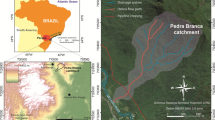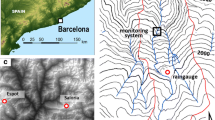Abstract
This article documents a 240,000-m3 debris flow resulting from a glacial lake outburst flood in Fjærland, Western Norway, May 8, 2004. The event started when a glacial lake breached a moraine ridge. The ensuing debris flow was able to erode material along its path, increasing in volume from about 25,000 to 240,000 m3 before depositing about 3 km from its starting point. Field investigations, pre- and post-flow aerial photographs as well as airborne laser scanning (LIDAR) were used to describe and investigate the flow. The most striking and unusual feature of this case study is the very pronounced erosion and bulking. We have made a detailed study of this aspect. Erosion and entrainment is quantified and the final volume of the debris flow is determined. We also present geometrical and sedimentological features of the final deposit. Based on the Fjærland data, we suggest that a self-sustaining mechanism might partly explain the extreme growth of debris flows traversing soft terrain.







Similar content being viewed by others
References
Aarseth I, Bogen J, Holtedahl H, Klakegg O, Nesje A, Rye N, Orheim O, Roland E (1988) Glaciology, hydrology and glacial geology around Jostedalsbreen. In: Orheim O (ed) A field guide to excursion 10 September–13 September 1988 organized in conjunction with Symposium on snow and glacier research relating to human living conditions. NVE and Norsk Polarinstitutt, Oslo
Anderson SP, Fernald KMH, Anderson RS, Humphrey NF (1999) Physical and chemical characterisation of a spring flood event, Bench Glacier, AK, USA: evidence for water storage. J Glaciol 45(150):177–189
Barstad B (1998) Datafangst for terrengmodellering med digital fotogrammetri. Fjellanger Widerøe. Forum for fotogrammetri og fjernmåling; 3-4 des., 1998
Berti M, Genevois R, Simoni A, Tecca PR (1999) Field observations of a debris flow event in the Dolomites. Geomorphology, 29:265–274
Brooks WE, Willett JC, Kent JD, Vasquez V, Rosales T (2005) The Muralla Pircada—an ancient Andean debris flow retention dam, Santa Rita B archaeological site, Chao Valley, Northern Peru. Landslides, 2:117–123
Carey M (2004) Living and dying with glaciers: people’s historical vulnerability to avalanches and outburst floods in Peru. Glob Planet Change 47:122–134
Cenderelli D, Wohl E (2003) Flow hydraulics and geomorphic effects of glacial-lake outburst floods in the Mount Everest region, Nepal. Earth Surf Process Landf 28:385–407
Chen J, He YP, Wei FQ (2005) Debris flow erosion and deposition in Jiangjia gully, Yunnan, China. Environ Geol 48:771–777
Genevois R, Tecca PR, Berti M, Simoni A (2000) Debris-flows in the dolomites: experimental data from a monitoring system. In: Wieczorek GF, Naeser ND (eds) Proceedings of the second international conference on debris-flow hazard mitigation: mechanics, prediction, and assessment. Balkema, Rotterdam, pp 283–291
Huerta DA, Ruiz-Súarez JC (2004) Vibration-induced granular segregation: a phenomenon driven by three mechanisms. Phys Rev Lett 92(11):4301–4304
Huggel C, Kääb A, Salzmann N (2004) GIS-based modeling of glacial hazards and their interactions using Landsat-TM and IKONOS imagery. Norsk Geografisk tidsskrift—Norwegian. J Geogr 58:761–773
Hungr O (2000) Analysis of debris flow surges using the theory of uniformly progressive flow. Earth Surf Process Landf 25:483–495
Hungr O, Morgan GC, Kellerhals R (1984) Quantitative analysis of debris torrent hazards for design of remedial measures. Can Geotech J 21:663–677
Hyyppä J, Pyysalo U, Hyyppä H, Samberg A (2000) Elevation Accuracy of Laser scanning-derived digital terrain and target models in forest environment. In: Proceedings of EARSeL-SIG-Workshop LIDAR, Dresden/FRG. EARSSeL eProceedings No. 1:139–147
Iverson RM (1997) The physics of debris flows. Rev Geophys 35(3):245–296
Iverson RM (2003) The debris-flow rheology myth. In: Rickenmann D, Chen C-I (eds) Proceedings of third international conference on debris-flow hazard mitigation: mechanics, prediction, and assessment. Millpress, Rotterdam, pp 303–314
Johnson AM (1984) Debris flow. In: Brunsden D, Prios DB (eds) Slope stability. Wilwy, New York, pp 257–290
Kattelmann R (2003) Glacial lake outburst floods in the Nepal Himalaya: a manageable hazard? Nat Hazards 28:145–154
Kershaw JA, Clague JJ, Evans SG (2005) Geomorphic and sedimentological signature of a two-phase outburst flood from moraine-dammed Queen Bess Lake, British Columbia, Canada. Earth Surf Process Landf 30:1–25
Lorenzini G, Mazza N (2004) Debris flow—phenomenology and rheological modelling. WIT Press, Southampton, UK
O’Connor JE, Hardison JH, Costa JE (2001) Debris flows from failures of Neoglacial-Age Moraine dams in the Three Sisters and Mount Jefferson Wilderness Areas, Oregon. US Geol. Surv. prof. pap. 1606, ISSN 1044–9612
Takahashi T (1991) Debris flow, IAHR Monograph Series, Balkema, Rotterdam
Tognacca C, Bezzola GR, Minor HE (2000) Threshold criterion for debris-flow initiation due to channel failure. In: Wieczorek GF, Naeser ND (eds) Proceedings of the second international conference on debris-flow hazard mitigation: mechanics, prediction, and assessment. Balkema, Rotterdam, pp 89–98
Vandine DF, Bovis M (2002) History and goals of Canadian debris-flow research, a review. Nat Hazards 26:69–82
Vilímek V, Zapata ML, Klimes J, Patzelt Z, Santillán N (2005) Influence of glacial retreat on natural hazards of the Palcacocha Lake area, Peru. Landslides, 2:107–115
Vuichard D, Zimmermann M (1987) The 1985 catastrophic drainage of a moraine-dammed lake, Khumbu Himal, Nepal: causes and consequences. Mt Res Dev 7:91–110
Acknowledgements
This work has been funded by VISTA (Norwegian Academy of Science and Letters together with Statoil), and by the Norwegian Research Council through the International Centre for Geohazards (ICG), Project 9: “Slide dynamics and mechanics of disintegration”.
We would like to thank Trond Eiken at the University of Oslo for helpful advice concerning the photogrammetry, all our colleagues at ICG for fruitful cooperation and Miriam Jackson at the Norwegian Water Resources and Energy Directorate (NVE) for valuable discussions concerning glaciology and the water volume involved in the debris flow. We are also grateful to Adrian Read for proofreading. Special thanks to the inhabitants of Supphelledalen in Fjærland for their hospitality and provision of valuable information.
This is ICG-contribution number 186.
Author information
Authors and Affiliations
Corresponding author
Rights and permissions
About this article
Cite this article
Breien, H., De Blasio, F.V., Elverhøi, A. et al. Erosion and morphology of a debris flow caused by a glacial lake outburst flood, Western Norway. Landslides 5, 271–280 (2008). https://doi.org/10.1007/s10346-008-0118-3
Received:
Accepted:
Published:
Issue Date:
DOI: https://doi.org/10.1007/s10346-008-0118-3




